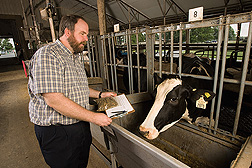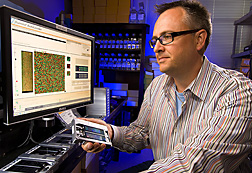Breeding and Genetic
Change in the Holstein Genome
The average American dairy cow produces more than 20,000 pounds of milk every year. Most of these cattle are Holsteins, a breed whose naturally high milk yield has been enhanced by decades of selective breeding.
The U.S. dairy industry intensified selective-breeding efforts in the 1960s. Since then, the average milk yield in Holsteins has doubled, but there has also been a substantial reduction in fertility. Recent research by scientists at the Agricultural Research Service’s Animal and Natural Resources Institute (ANRI) in Beltsville, Maryland, and the University of Minnesota (UM) suggests there may be a genetic connection between increased milk yields and reduced fertility.
Since the 1960s, UM scientists have maintained a herd of cattle that were never exposed to the selective-breeding practices used by the U.S. dairy industry. As a result, their genomes represent a snapshot of a time before dairy cattle selection efforts intensified.
|
|
Scientists in ANRI’s Bovine Functional Genomics Laboratory and Animal Improvement Programs Laboratory teamed up with UM colleagues under the leadership of UM geneticist Yang Da to compare the genomes of modern Holsteins with those of the UM cattle.
While scientists have significantly improved their understanding of animal genetics over the past 250 years, questions about how long-term breeding influences genome structure are still largely unanswered. Fortunately, improvements in storage, preservation, and shipping technology make it easier to maintain and transport genetic material today than at any other time in history—and that makes comparative studies involving historic DNA more practical than ever.
The investigation involved about 50,000 genetic markers known as “single nucleotide polymorphisms,” or SNPs (pronounced “snips”), drawn from about 2,000 cattle. ANRI geneticist John Cole coordinated collection of Holstein DNA samples from the ARS National Center for Genetic Resources Preservation (NCGRP), the U.S. Holstein Association, and five U.S. universities, including UM.
Genome Analysis
Under the leadership of ANRI geneticist Tad Sonstegard, the scientists extracted DNA and genotyped the samples with an Illumina Bovine SNP50 BeadChip, a genetic analysis tool developed by Sonstegard and ANRI geneticist Curt Van Tassell in collaboration with industry, university, and other ARS partners.
The BeadChip is a glass slide capable of generating genetic information that can assist scientists in comparative genetic studies. Each BeadChip is designed to characterize 12 different samples, and each sample is analyzed at more than 50,000 SNP marker locations, referred to as “loci.” The scientists decode all the SNP marker information to determine the specific allele combinations at each locus for every sample. In this case, an “allele” represents one of the two detectable forms of a gene. DNA information gleaned from the BeadChip allows scientists to determine which allele was inherited from the mother and which was inherited from the father. An animal can receive the same allele type from both parents or a different allele from each parent. Differences in alleles can result in different characteristics.
“A decade ago, this kind of genotyping work was much more expensive and time consuming,” Van Tassell says. “The BeadChip makes it possible to get the information faster and more economically.”
The scientists analyzed the allele data to determine which regions of the genome were most likely to have been affected by the selection practices used by the dairy industry to improve milk production over the past 40 years.
The researchers are now focused on six genomic regions that had been identified as being associated with milk yield. The genomic changes made evident by the analysis were “extensive,” Sonstegard says. As much as 30 percent of the Holstein genome may have been influenced by standard breeding practices.
“Small changes in allele frequency do occur randomly,” Van Tassell says. “But significant changes like these are rare and are almost certainly the result of selection.”
The scientists observed that many of the genes and chromosome regions associated with milk yield were also related to lowered fertility rate, supporting their hypothesis of a genetic link between the two traits. Since high yield and high fertility are both desirable traits, it’s important for producers to recognize that there may be a tradeoff between the two.
“Ultimately, this work may help us understand the limitations of biology as we work to breed a high-performance dairy cow,” Cole says.—By Laura McGinnis, formerly with ARS.
This research is part of Food Animal Production, an ARS national program (#101) described on the World Wide Web at www.nps.ars.usda.gov.
To reach scientists mentioned in this article, contact Robert Sowers, USDA-ARS Information Staff, 5601 Sunnyside Ave., Beltsville, MD 20705-5129; phone (301) 504-1651, fax (301) 504-1486.
Cattle Genome Research at BARC
The BeadChip is barely bigger than a stick of gum, but it’s having a major impact on a diverse collection of research efforts.
Researchers at the ARS Beltsville Agricultural Research Center (BARC), in partnership with Merial (Duluth, Georgia), are using the BeadChip to investigate how genes influence cattle susceptibility to parasitic nematodes. Most cattle are reasonably resistant to gastrointestinal nematodes—wormlike creatures that can live comfortably in water, soil, or, in the case of parasitic nematodes, in many different host species. But some cattle lack resistance to these nematodes, which can harm their health.
Led by microbiologist Louis Gasbarre, BARC scientists have gathered DNA samples from more than 400 Angus cattle that demonstrated either significant susceptibility or significant resistance to these parasites. The team has identified several genomic regions related to nematode resistance.
BARC researchers have also used the BeadChip to improve selection accuracy for dairy cattle. Comparing SNPs from bull DNA with SNPs on the BeadChip can identify bulls with good genetic potential about 70 percent of the time. In comparison, DNA tests used by the industry for the past decade had a success rate of about 35 percent. Identifying individuals that are likely to pass on desirable traits could save producers time and money.
ARS is contributing to similar work outside the United States. With assistance from international development agencies, ARS and other collaborators are investigating how the BeadChip and other genomic tools can be used to help cattle farmers intensify production using native breeds. BARC scientists are collaborating with scientists around the world to gather information about parentage, breed, and inherited traits to help farmers make informed decisions about selective breeding.—By Laura McGinnis, formerly with ARS.
"Breeding and Genetic Change in the Holstein Genome" was published in the October 2009 issue of Agricultural Research magazine.









